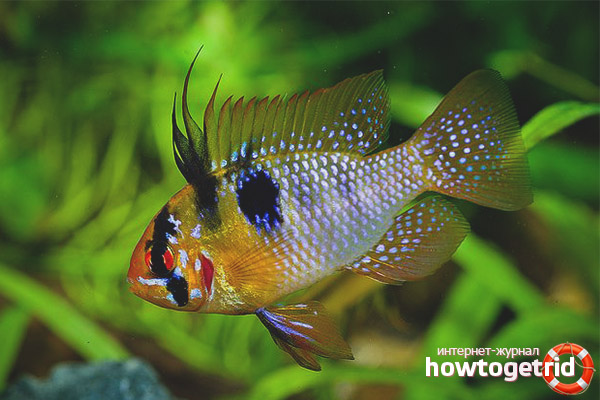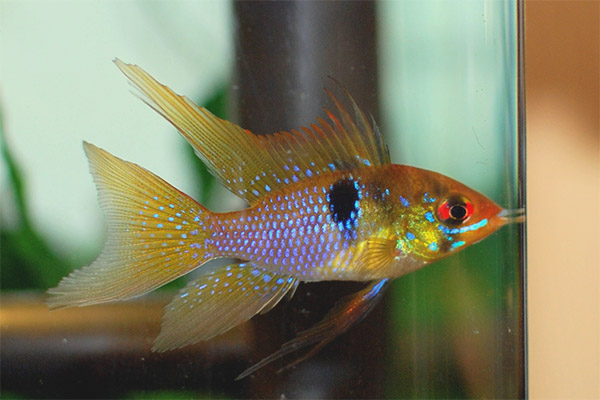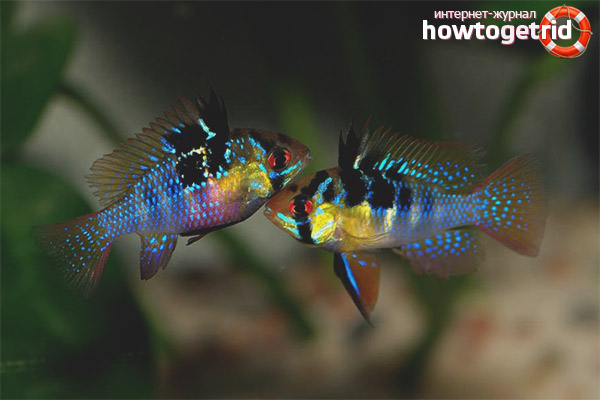The content of the article
The Latin name of the fish Ramisza apistogramma sounds like Mikrogeophagus Ramirezi. The whole mass of other names is connected with it. It has the appearance of a small, beautiful, rather peaceful fish, which is inhabited by an aquarium. Its cousin is the Bolivian butterfly. Despite the fact that Ramirezi was discovered much later than its relative, today it is more prevalent and is sold much more often. In an artificial aquarium environment, it can grow up to 5 cm. In the wild, larger specimens can be found.
There are some varieties of this fish that were bred artificially. There is a veil, neon fish, gold, other representatives.But not only a variety of forms characterized by this amazing fish. She also has a whole lot of different names. Some aquarists are often confused with these names, although, despite the variety of names, the same species is meant. Between themselves, they differ in color and shape of the body.
Intragenic crossing and mixing of blood led to the fact that the fish gradually degenerated. There were various variations of it, such as an electric blue blu or gold. Of course, they all have a brighter color, but at the same time they acquire weakened immunity, which entails frequent diseases. Sometimes those who breed fish for sale use hormone injections to make them more attractive. Therefore, when buying should be very careful and better to buy it from familiar sellers. Otherwise, such a fish stuffed with hormones, after a while will lose all its attractiveness and die.
Chromis butterfly is less aggressive compared to other cyclides. At the same time, it is more capricious, and its content is characterized by increased complexity.Ramerizi, because it has a peaceful nature, may well be kept together with other fish, whose habitat is a common aquarium. It will coexist quite peacefully, for example, with gupi. Sometimes, however, individual signs of aggression are observed. But this is more attributed to attempts to scare, rather than attack. Yes, and this can occur only when someone shamelessly went to their territory.
Ramirezi in nature
Fish loves places where there is still water. It does not tolerate a strong current, but it is completely free in waters with a weak current. Selects places where there is a sandy or muddy bottom and an abundance of vegetation. For food, she buries herself in the ground and searches for food there for her food.Sometimes it can eat, coming to the surface of the water surface.
general description
Oval contours of the body with high fins characterize the appearance of the fish. In the male they have a more pointed appearance. Representatives of females are smaller in size than males. When aquarium content can grow up to 5 cm. Proper maintenance ensures the survival of fish for 4 years.
The fish has a rather pronounced external attractiveness. The yellow head is equipped with red eyes. The body itself casts a blue with a violet hue. The body has the location of a black spot. Fins with bright, distinct color. Different forms have a wide variation of color. Often unscrupulous sellers use hormones in fish food. From this, colors become even richer. But, acquiring such an instance, it can be noted that the brightness of the color will quickly disappear, and the fish itself will become homely in appearance.
The complexity of the content

If you wish to contain this type of fish, the best option would be a butterfly. The small size of the fish has a peaceful nature and is able to consume a variety of food.It does not show particular demands on the characteristics of water parameters. However, it is very sensitive to their change. The fish is well adapted to the existing conditions of detention. Breeding is not particularly difficult, but the cultivation of fry is associated with certain difficulties.
Fact! Currently, representatives of this species are very weak, and therefore, often die during the first year after purchase.
In all likelihood, the cause of poor health lies in the fact that for a long time there has been no renewal of blood, the body simply weakened. A certain imprint imposes and growing them on farms in Asia. It is contained in conditions of elevated temperatures of about 30 degrees. For growing water is used only precipitation.
Feeding
In the wild, fish use plants for food. In the course are small representatives of the kingdom of insects. To find them, she buries herself in the ground. While in the aquarium, bloodworms, artemia, tubule and other feed are used for food. Feeding is carried out three times a day. At one time give a small portion.Fish is extremely timid. Control is required so that her restless neighbors do not interfere with nutrition.
Rules for content
The tank capacity should be at least 70 liters. Fish require clean water, which contains large amounts of oxygen. It is better if there is a small flow. Water should change every week. Also required to blow the ground. The fish lives mainly at the bottom. If the soil is not blown, increased ammonia content may accumulate, and this will certainly affect the health of the fish. It will be great if there is the possibility of weekly measurements of the ammonia content in the water. Conduct the use of both external and internal filter. The latter option is preferred.
Soil requires the use of sand or small gravel. Do not forget that the butterfly loves to rummage in the ground. Aquarium decoration should be made with the presence of a style characteristic of South America. It would be appropriate to use pots, koryag, thick bushes. You can use fallen leaves from trees. All this is necessary for maximum imitation of the conditions of the wild nature.
Fish do not tolerate bright color. Therefore, the water should be plants. Ideal for content will be a temperature in the range from 24 to 28 degrees. The pH should not be lower than 6.0, but not higher than 7.5.
Neighborhood with other fish
It is quite admissible if the butterfly is kept in the general aquarium, where there are peaceful small fish. As for herself, she will easily get along with any fish, but they can offend her. They can coexist with various viviparous representatives. This applies to guppies, swordtails, plazily, other representatives. Allowed to be shared with large shrimp. Their butterfly will not touch, but small representatives may well be considered feed.
Butterflies live alone and in pairs. For the content of several pairs of the aquarium should be spacious enough in its volume. Tsikhlida - fish, preferring to abide by the principle of territoriality. If one pair is acquired, this does not mean that spawning will take place. For the purpose of breeding, you must purchase at least a dozen pairs. At the same time there is an opportunity to choose a partner.
Distinctive sex characteristics
The female has a brighter belly. It is orange or scarlet. The male is larger in size. Their body is equipped with a more pointed fin shape.
Breeding
Being in the wild, the fish are bound in pairs. They are stable. When spawning, the female is able to lay 150-200 eggs at a time. As for the aquarium, for the offspring, 6-10 pairs of juveniles are acquired. They grow together, and then make the choice of a partner. If a pair is acquired, it is not a fact that a spawning will take place.
The place of deposition of eggs is the surface of smooth stones or wide leaves. This usually happens in the evening at a temperature of 25-28 degrees. To do this, they choose a quiet place so that no one bothers them. During stress, the fish may well eat caviar. Then the parents are removed from the aquarium and raise the fry on their own. Before laying caviar on a rock, a couple spends a lot of time to clean its surface. At one time, the female is able to postpone 150-200 eggs, and the male is engaged in their fertilization.
The female with the male in every way guarded the eggs.To this end, they are fanning it with fins. In these moments, the fish are of particular beauty. After the deposition of eggs, the larvae gradually begin to hatch. After some time the fry can swim independently. The female is trying to seed the fry in a place inaccessible to outsiders. Sometimes the male attempts to attack the female. Then the male should be transplanted. For some couples, the division of a common flock into equal groups is characteristic. But the male takes care of all without exception. It is not characterized by any selectivity.
Fry are very sensitive to the parameters of the water in which they are located. Stable maintenance of a certain temperature is required.Water must always be clean and free from impurities. Protection of male fry lasts for three weeks. Then he stops doing it. At this time, jigging of the male is required.
Water must be changed every day, but in the amount of not more than 10% of the total. When the male is deposited, the volume of water being replaced is increased to 30%. The added water is necessarily passed through osmosis.
Independent raising of small fish fry The Ramiseri Apistogram is not an easy task at all. It takes a lot of effort and effort to create optimal conditions for the growth and development of this representative ichthyofauna.
Video: ramisi apistogram - maintenance and breeding












To send